Financial Management Report: Principles, Decisions, and Sustainability
VerifiedAdded on 2023/01/13
|17
|5329
|4
Report
AI Summary
This financial management report delves into various aspects of strategic financial planning, organization, direction, and control within an organization. The report begins by examining formal and informal approaches to decision-making, highlighting their advantages and disadvantages. It then explores key financial management principles essential for achieving long-term financial sustainability, including setting objectives, organizing finances, maximizing shareholder wealth, and managing debt. The report further evaluates the roles of management accountants and accounting control systems in ethical financial management. Finally, it analyzes how data supports operational and strategic decisions, compares investment appraisal techniques, and discusses the role of management accounting in improving financial sustainability. The report underscores the importance of financial decision-making for long-term organizational success and provides valuable insights into effective financial management practices.

FINANCIAL
MANAGEMENT
MANAGEMENT
Paraphrase This Document
Need a fresh take? Get an instant paraphrase of this document with our AI Paraphraser
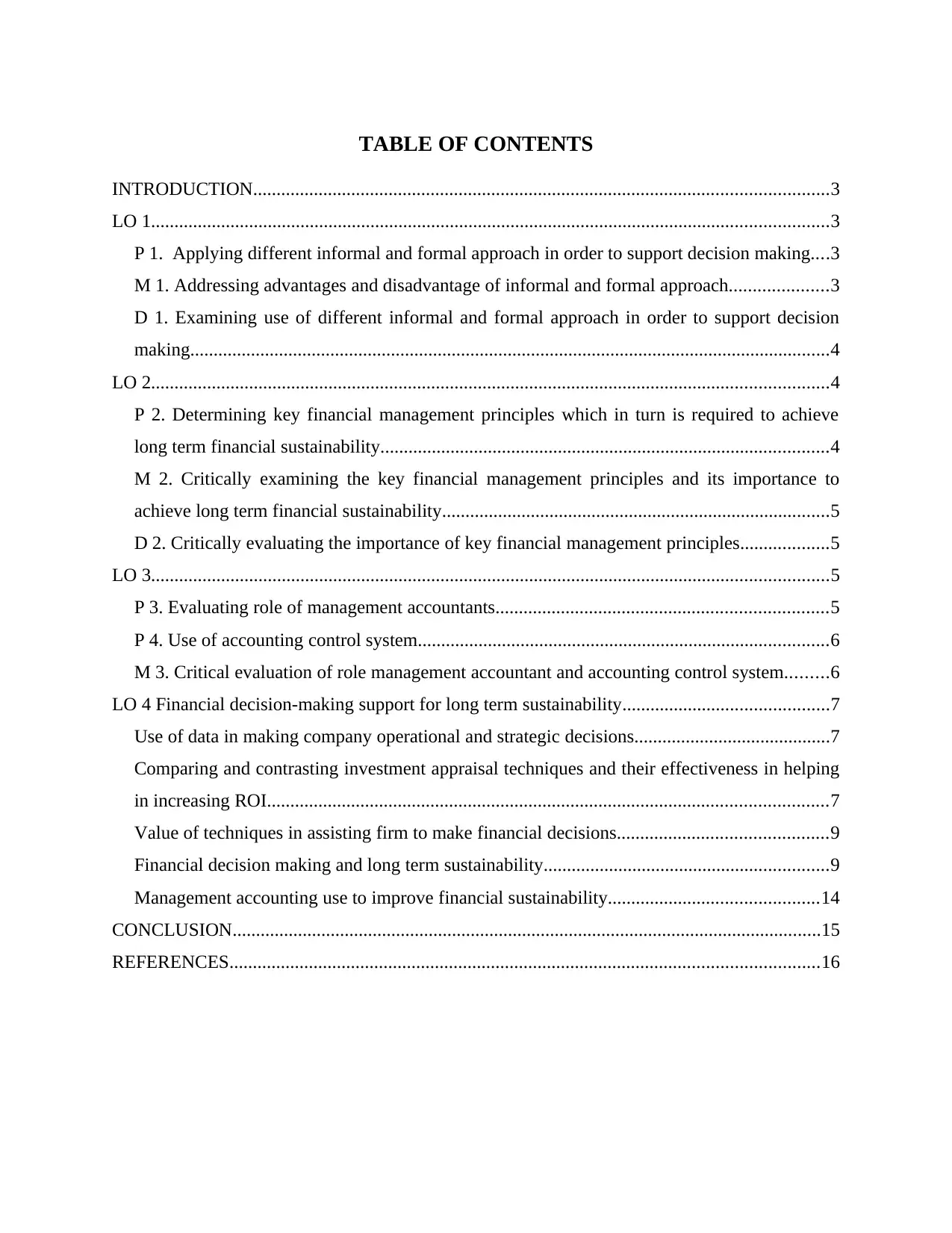
TABLE OF CONTENTS
INTRODUCTION...........................................................................................................................3
LO 1.................................................................................................................................................3
P 1. Applying different informal and formal approach in order to support decision making....3
M 1. Addressing advantages and disadvantage of informal and formal approach.....................3
D 1. Examining use of different informal and formal approach in order to support decision
making.........................................................................................................................................4
LO 2.................................................................................................................................................4
P 2. Determining key financial management principles which in turn is required to achieve
long term financial sustainability................................................................................................4
M 2. Critically examining the key financial management principles and its importance to
achieve long term financial sustainability...................................................................................5
D 2. Critically evaluating the importance of key financial management principles...................5
LO 3.................................................................................................................................................5
P 3. Evaluating role of management accountants.......................................................................5
P 4. Use of accounting control system........................................................................................6
M 3. Critical evaluation of role management accountant and accounting control system.........6
LO 4 Financial decision-making support for long term sustainability............................................7
Use of data in making company operational and strategic decisions..........................................7
Comparing and contrasting investment appraisal techniques and their effectiveness in helping
in increasing ROI........................................................................................................................7
Value of techniques in assisting firm to make financial decisions.............................................9
Financial decision making and long term sustainability.............................................................9
Management accounting use to improve financial sustainability.............................................14
CONCLUSION..............................................................................................................................15
REFERENCES..............................................................................................................................16
INTRODUCTION...........................................................................................................................3
LO 1.................................................................................................................................................3
P 1. Applying different informal and formal approach in order to support decision making....3
M 1. Addressing advantages and disadvantage of informal and formal approach.....................3
D 1. Examining use of different informal and formal approach in order to support decision
making.........................................................................................................................................4
LO 2.................................................................................................................................................4
P 2. Determining key financial management principles which in turn is required to achieve
long term financial sustainability................................................................................................4
M 2. Critically examining the key financial management principles and its importance to
achieve long term financial sustainability...................................................................................5
D 2. Critically evaluating the importance of key financial management principles...................5
LO 3.................................................................................................................................................5
P 3. Evaluating role of management accountants.......................................................................5
P 4. Use of accounting control system........................................................................................6
M 3. Critical evaluation of role management accountant and accounting control system.........6
LO 4 Financial decision-making support for long term sustainability............................................7
Use of data in making company operational and strategic decisions..........................................7
Comparing and contrasting investment appraisal techniques and their effectiveness in helping
in increasing ROI........................................................................................................................7
Value of techniques in assisting firm to make financial decisions.............................................9
Financial decision making and long term sustainability.............................................................9
Management accounting use to improve financial sustainability.............................................14
CONCLUSION..............................................................................................................................15
REFERENCES..............................................................................................................................16

INTRODUCTION
Financial management is considered to be one of the crucial approach which helps in
strategically plan, organize, direct and effectively control the financial undertaking within the set
organization. It is considered to be an appropriate approach which helps in strategic decision
making. This study determines the various different approaches in order to support effective
decision making. It also helps in analysing financial management principles in order to support
financial strategies. Furthermore, this study also helps in analysing the role associated with the
accounting control system and management accountants. This study further demonstrates various
ways where financial decision making helps in supporting sustainable performance.
LO 1
P 1. Applying different informal and formal approach in order to support decision making.
Formal approach mainly comprises of system, structure and processes which in turn helps
in strategic decision making. Formal organizational structure in turn helps in formalizing the
relationship between members and process of the Barratt development. This in turn helps in
creating better business environment which helps in better decision-making process. Formal
consensus tends to support various layers of top executives which helps in better decision-
making process. Organization system is considered to be as the defined structure which helps in
dividing organization into various hierarchical structure. This helps in reducing chaos and better
transmission of decision across departments which eventually leads to better decision making.
Organization process is mainly linked with planning, assigning tasks, accomplishing goals, etc.
which in turn helps in better decision making. On the contrary, informal approach mainly
comprise of relationship, unwritten rules and networks which in turn helps in supporting decision
making. Relationship between the managers and employees of the organization in turn helps in
making strategic decision within the management of the Barratt development. Unwritten rules
mainly comprise of the unconscious accumulation of the history, customs, beliefs, vested
interest, deep feelings, etc. which in turn largely support decision making. Social networks and
connects within and outside the organization aids to better decision making.
M 1. Addressing advantages and disadvantage of informal and formal approach.
The advantage of the formal approach in the organization helps in collaborating the
activities within each organization. It helps in setting clear idea and coordinate activities of
various functional and hierarchical departments of the Lloyd banks. On the contrary, the major
Financial management is considered to be one of the crucial approach which helps in
strategically plan, organize, direct and effectively control the financial undertaking within the set
organization. It is considered to be an appropriate approach which helps in strategic decision
making. This study determines the various different approaches in order to support effective
decision making. It also helps in analysing financial management principles in order to support
financial strategies. Furthermore, this study also helps in analysing the role associated with the
accounting control system and management accountants. This study further demonstrates various
ways where financial decision making helps in supporting sustainable performance.
LO 1
P 1. Applying different informal and formal approach in order to support decision making.
Formal approach mainly comprises of system, structure and processes which in turn helps
in strategic decision making. Formal organizational structure in turn helps in formalizing the
relationship between members and process of the Barratt development. This in turn helps in
creating better business environment which helps in better decision-making process. Formal
consensus tends to support various layers of top executives which helps in better decision-
making process. Organization system is considered to be as the defined structure which helps in
dividing organization into various hierarchical structure. This helps in reducing chaos and better
transmission of decision across departments which eventually leads to better decision making.
Organization process is mainly linked with planning, assigning tasks, accomplishing goals, etc.
which in turn helps in better decision making. On the contrary, informal approach mainly
comprise of relationship, unwritten rules and networks which in turn helps in supporting decision
making. Relationship between the managers and employees of the organization in turn helps in
making strategic decision within the management of the Barratt development. Unwritten rules
mainly comprise of the unconscious accumulation of the history, customs, beliefs, vested
interest, deep feelings, etc. which in turn largely support decision making. Social networks and
connects within and outside the organization aids to better decision making.
M 1. Addressing advantages and disadvantage of informal and formal approach.
The advantage of the formal approach in the organization helps in collaborating the
activities within each organization. It helps in setting clear idea and coordinate activities of
various functional and hierarchical departments of the Lloyd banks. On the contrary, the major
⊘ This is a preview!⊘
Do you want full access?
Subscribe today to unlock all pages.

Trusted by 1+ million students worldwide
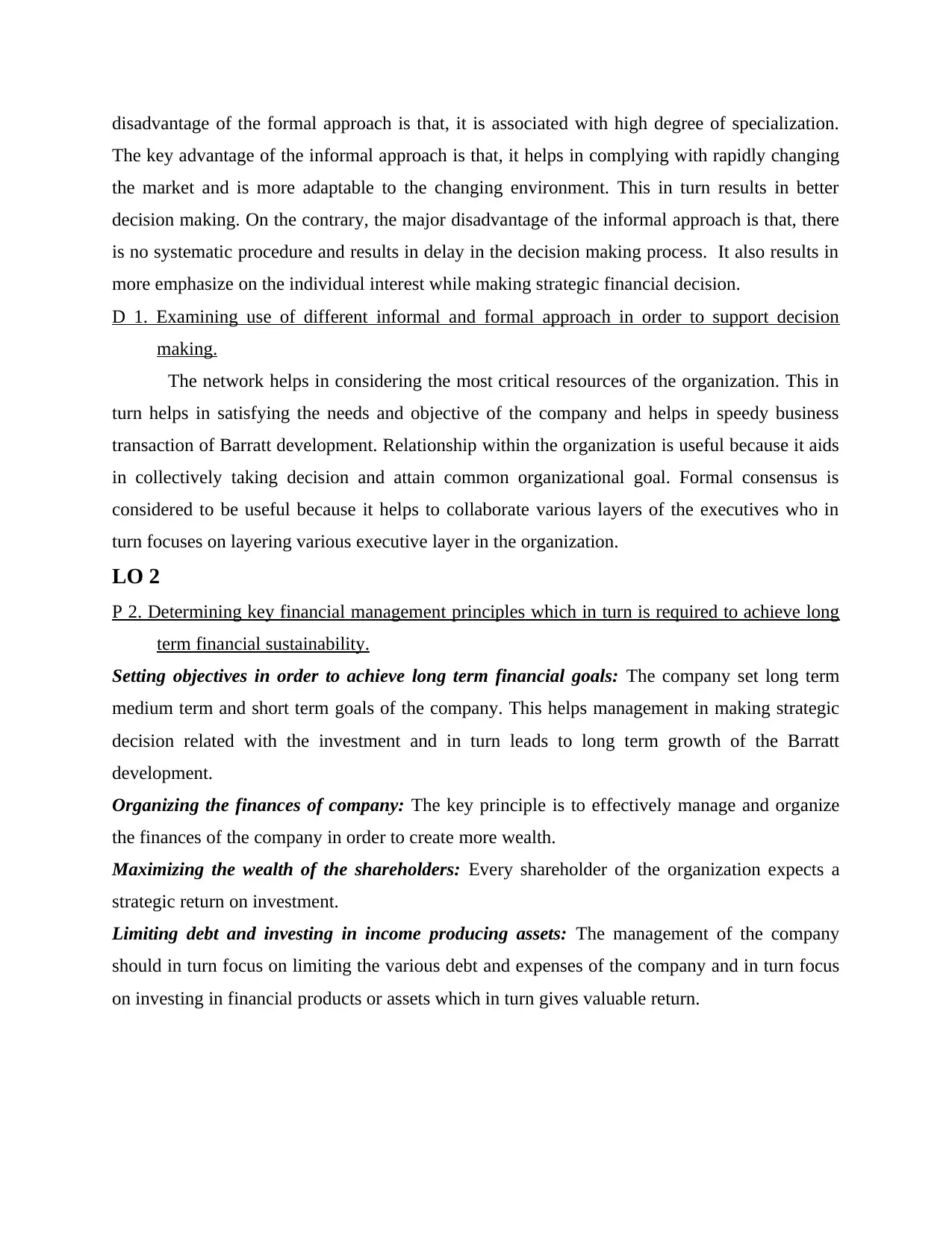
disadvantage of the formal approach is that, it is associated with high degree of specialization.
The key advantage of the informal approach is that, it helps in complying with rapidly changing
the market and is more adaptable to the changing environment. This in turn results in better
decision making. On the contrary, the major disadvantage of the informal approach is that, there
is no systematic procedure and results in delay in the decision making process. It also results in
more emphasize on the individual interest while making strategic financial decision.
D 1. Examining use of different informal and formal approach in order to support decision
making.
The network helps in considering the most critical resources of the organization. This in
turn helps in satisfying the needs and objective of the company and helps in speedy business
transaction of Barratt development. Relationship within the organization is useful because it aids
in collectively taking decision and attain common organizational goal. Formal consensus is
considered to be useful because it helps to collaborate various layers of the executives who in
turn focuses on layering various executive layer in the organization.
LO 2
P 2. Determining key financial management principles which in turn is required to achieve long
term financial sustainability.
Setting objectives in order to achieve long term financial goals: The company set long term
medium term and short term goals of the company. This helps management in making strategic
decision related with the investment and in turn leads to long term growth of the Barratt
development.
Organizing the finances of company: The key principle is to effectively manage and organize
the finances of the company in order to create more wealth.
Maximizing the wealth of the shareholders: Every shareholder of the organization expects a
strategic return on investment.
Limiting debt and investing in income producing assets: The management of the company
should in turn focus on limiting the various debt and expenses of the company and in turn focus
on investing in financial products or assets which in turn gives valuable return.
The key advantage of the informal approach is that, it helps in complying with rapidly changing
the market and is more adaptable to the changing environment. This in turn results in better
decision making. On the contrary, the major disadvantage of the informal approach is that, there
is no systematic procedure and results in delay in the decision making process. It also results in
more emphasize on the individual interest while making strategic financial decision.
D 1. Examining use of different informal and formal approach in order to support decision
making.
The network helps in considering the most critical resources of the organization. This in
turn helps in satisfying the needs and objective of the company and helps in speedy business
transaction of Barratt development. Relationship within the organization is useful because it aids
in collectively taking decision and attain common organizational goal. Formal consensus is
considered to be useful because it helps to collaborate various layers of the executives who in
turn focuses on layering various executive layer in the organization.
LO 2
P 2. Determining key financial management principles which in turn is required to achieve long
term financial sustainability.
Setting objectives in order to achieve long term financial goals: The company set long term
medium term and short term goals of the company. This helps management in making strategic
decision related with the investment and in turn leads to long term growth of the Barratt
development.
Organizing the finances of company: The key principle is to effectively manage and organize
the finances of the company in order to create more wealth.
Maximizing the wealth of the shareholders: Every shareholder of the organization expects a
strategic return on investment.
Limiting debt and investing in income producing assets: The management of the company
should in turn focus on limiting the various debt and expenses of the company and in turn focus
on investing in financial products or assets which in turn gives valuable return.
Paraphrase This Document
Need a fresh take? Get an instant paraphrase of this document with our AI Paraphraser
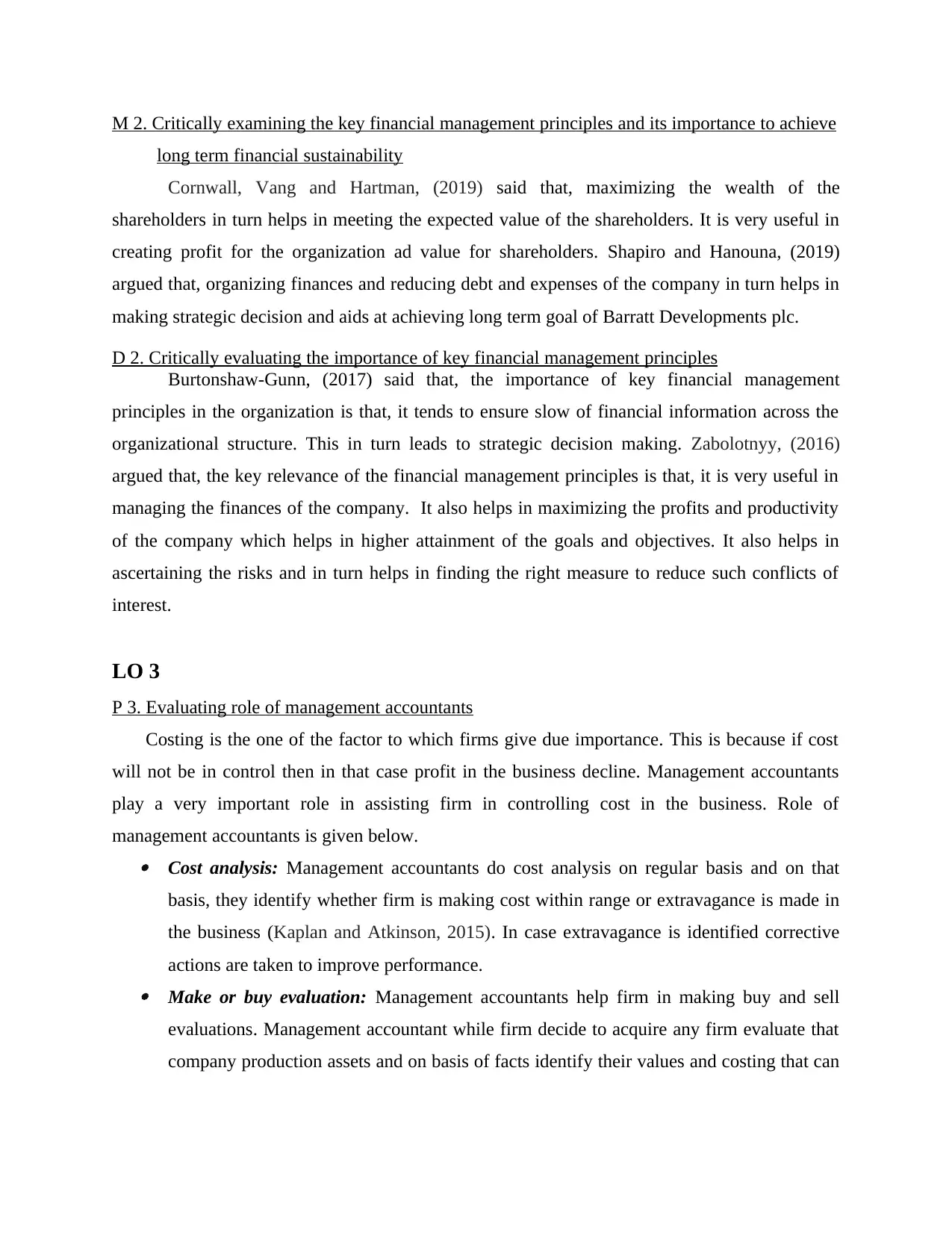
M 2. Critically examining the key financial management principles and its importance to achieve
long term financial sustainability
Cornwall, Vang and Hartman, (2019) said that, maximizing the wealth of the
shareholders in turn helps in meeting the expected value of the shareholders. It is very useful in
creating profit for the organization ad value for shareholders. Shapiro and Hanouna, (2019)
argued that, organizing finances and reducing debt and expenses of the company in turn helps in
making strategic decision and aids at achieving long term goal of Barratt Developments plc.
D 2. Critically evaluating the importance of key financial management principles
Burtonshaw-Gunn, (2017) said that, the importance of key financial management
principles in the organization is that, it tends to ensure slow of financial information across the
organizational structure. This in turn leads to strategic decision making. Zabolotnyy, (2016)
argued that, the key relevance of the financial management principles is that, it is very useful in
managing the finances of the company. It also helps in maximizing the profits and productivity
of the company which helps in higher attainment of the goals and objectives. It also helps in
ascertaining the risks and in turn helps in finding the right measure to reduce such conflicts of
interest.
LO 3
P 3. Evaluating role of management accountants
Costing is the one of the factor to which firms give due importance. This is because if cost
will not be in control then in that case profit in the business decline. Management accountants
play a very important role in assisting firm in controlling cost in the business. Role of
management accountants is given below. Cost analysis: Management accountants do cost analysis on regular basis and on that
basis, they identify whether firm is making cost within range or extravagance is made in
the business (Kaplan and Atkinson, 2015). In case extravagance is identified corrective
actions are taken to improve performance. Make or buy evaluation: Management accountants help firm in making buy and sell
evaluations. Management accountant while firm decide to acquire any firm evaluate that
company production assets and on basis of facts identify their values and costing that can
long term financial sustainability
Cornwall, Vang and Hartman, (2019) said that, maximizing the wealth of the
shareholders in turn helps in meeting the expected value of the shareholders. It is very useful in
creating profit for the organization ad value for shareholders. Shapiro and Hanouna, (2019)
argued that, organizing finances and reducing debt and expenses of the company in turn helps in
making strategic decision and aids at achieving long term goal of Barratt Developments plc.
D 2. Critically evaluating the importance of key financial management principles
Burtonshaw-Gunn, (2017) said that, the importance of key financial management
principles in the organization is that, it tends to ensure slow of financial information across the
organizational structure. This in turn leads to strategic decision making. Zabolotnyy, (2016)
argued that, the key relevance of the financial management principles is that, it is very useful in
managing the finances of the company. It also helps in maximizing the profits and productivity
of the company which helps in higher attainment of the goals and objectives. It also helps in
ascertaining the risks and in turn helps in finding the right measure to reduce such conflicts of
interest.
LO 3
P 3. Evaluating role of management accountants
Costing is the one of the factor to which firms give due importance. This is because if cost
will not be in control then in that case profit in the business decline. Management accountants
play a very important role in assisting firm in controlling cost in the business. Role of
management accountants is given below. Cost analysis: Management accountants do cost analysis on regular basis and on that
basis, they identify whether firm is making cost within range or extravagance is made in
the business (Kaplan and Atkinson, 2015). In case extravagance is identified corrective
actions are taken to improve performance. Make or buy evaluation: Management accountants help firm in making buy and sell
evaluations. Management accountant while firm decide to acquire any firm evaluate that
company production assets and on basis of facts identify their values and costing that can
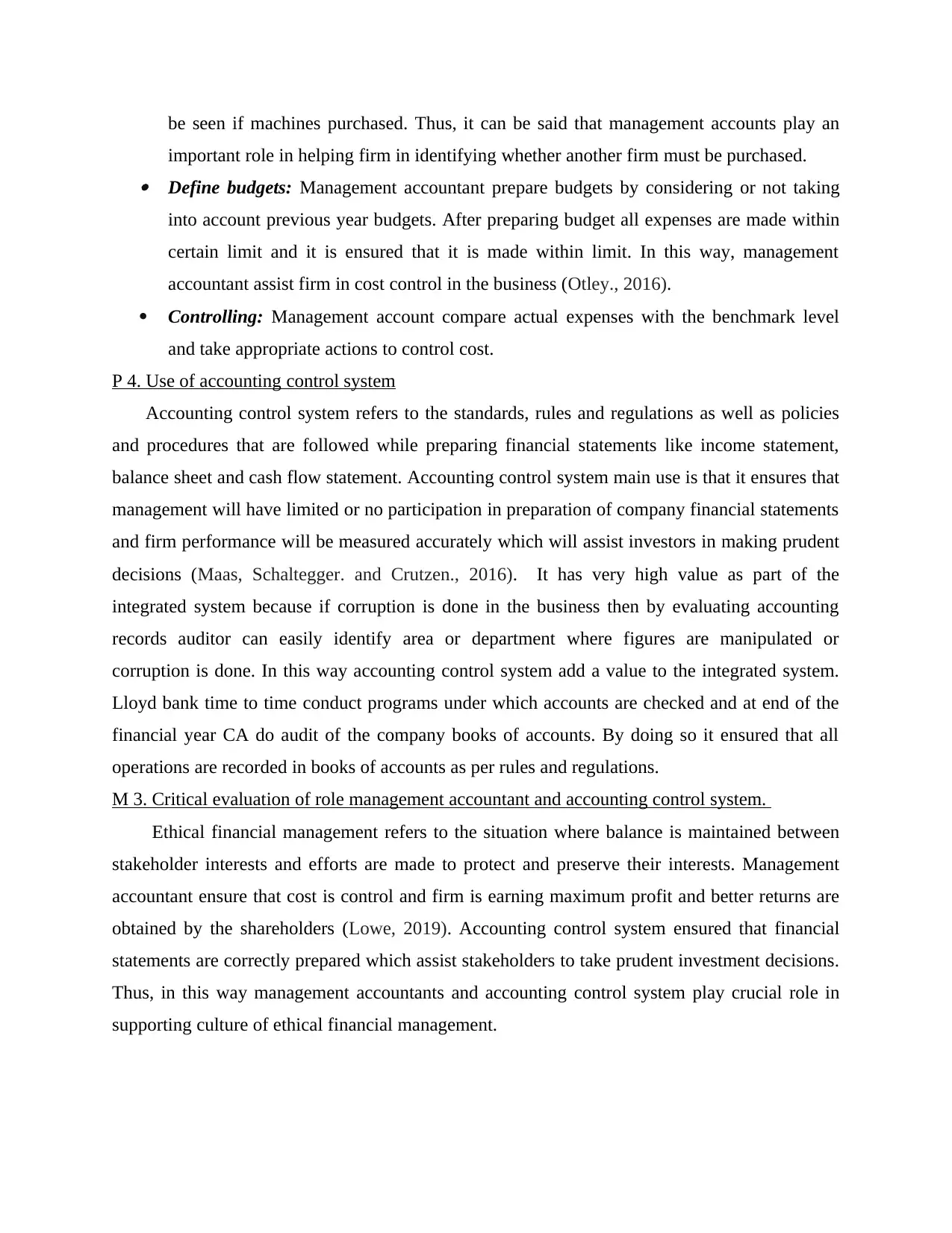
be seen if machines purchased. Thus, it can be said that management accounts play an
important role in helping firm in identifying whether another firm must be purchased. Define budgets: Management accountant prepare budgets by considering or not taking
into account previous year budgets. After preparing budget all expenses are made within
certain limit and it is ensured that it is made within limit. In this way, management
accountant assist firm in cost control in the business (Otley., 2016).
Controlling: Management account compare actual expenses with the benchmark level
and take appropriate actions to control cost.
P 4. Use of accounting control system
Accounting control system refers to the standards, rules and regulations as well as policies
and procedures that are followed while preparing financial statements like income statement,
balance sheet and cash flow statement. Accounting control system main use is that it ensures that
management will have limited or no participation in preparation of company financial statements
and firm performance will be measured accurately which will assist investors in making prudent
decisions (Maas, Schaltegger. and Crutzen., 2016). It has very high value as part of the
integrated system because if corruption is done in the business then by evaluating accounting
records auditor can easily identify area or department where figures are manipulated or
corruption is done. In this way accounting control system add a value to the integrated system.
Lloyd bank time to time conduct programs under which accounts are checked and at end of the
financial year CA do audit of the company books of accounts. By doing so it ensured that all
operations are recorded in books of accounts as per rules and regulations.
M 3. Critical evaluation of role management accountant and accounting control system.
Ethical financial management refers to the situation where balance is maintained between
stakeholder interests and efforts are made to protect and preserve their interests. Management
accountant ensure that cost is control and firm is earning maximum profit and better returns are
obtained by the shareholders (Lowe, 2019). Accounting control system ensured that financial
statements are correctly prepared which assist stakeholders to take prudent investment decisions.
Thus, in this way management accountants and accounting control system play crucial role in
supporting culture of ethical financial management.
important role in helping firm in identifying whether another firm must be purchased. Define budgets: Management accountant prepare budgets by considering or not taking
into account previous year budgets. After preparing budget all expenses are made within
certain limit and it is ensured that it is made within limit. In this way, management
accountant assist firm in cost control in the business (Otley., 2016).
Controlling: Management account compare actual expenses with the benchmark level
and take appropriate actions to control cost.
P 4. Use of accounting control system
Accounting control system refers to the standards, rules and regulations as well as policies
and procedures that are followed while preparing financial statements like income statement,
balance sheet and cash flow statement. Accounting control system main use is that it ensures that
management will have limited or no participation in preparation of company financial statements
and firm performance will be measured accurately which will assist investors in making prudent
decisions (Maas, Schaltegger. and Crutzen., 2016). It has very high value as part of the
integrated system because if corruption is done in the business then by evaluating accounting
records auditor can easily identify area or department where figures are manipulated or
corruption is done. In this way accounting control system add a value to the integrated system.
Lloyd bank time to time conduct programs under which accounts are checked and at end of the
financial year CA do audit of the company books of accounts. By doing so it ensured that all
operations are recorded in books of accounts as per rules and regulations.
M 3. Critical evaluation of role management accountant and accounting control system.
Ethical financial management refers to the situation where balance is maintained between
stakeholder interests and efforts are made to protect and preserve their interests. Management
accountant ensure that cost is control and firm is earning maximum profit and better returns are
obtained by the shareholders (Lowe, 2019). Accounting control system ensured that financial
statements are correctly prepared which assist stakeholders to take prudent investment decisions.
Thus, in this way management accountants and accounting control system play crucial role in
supporting culture of ethical financial management.
⊘ This is a preview!⊘
Do you want full access?
Subscribe today to unlock all pages.

Trusted by 1+ million students worldwide
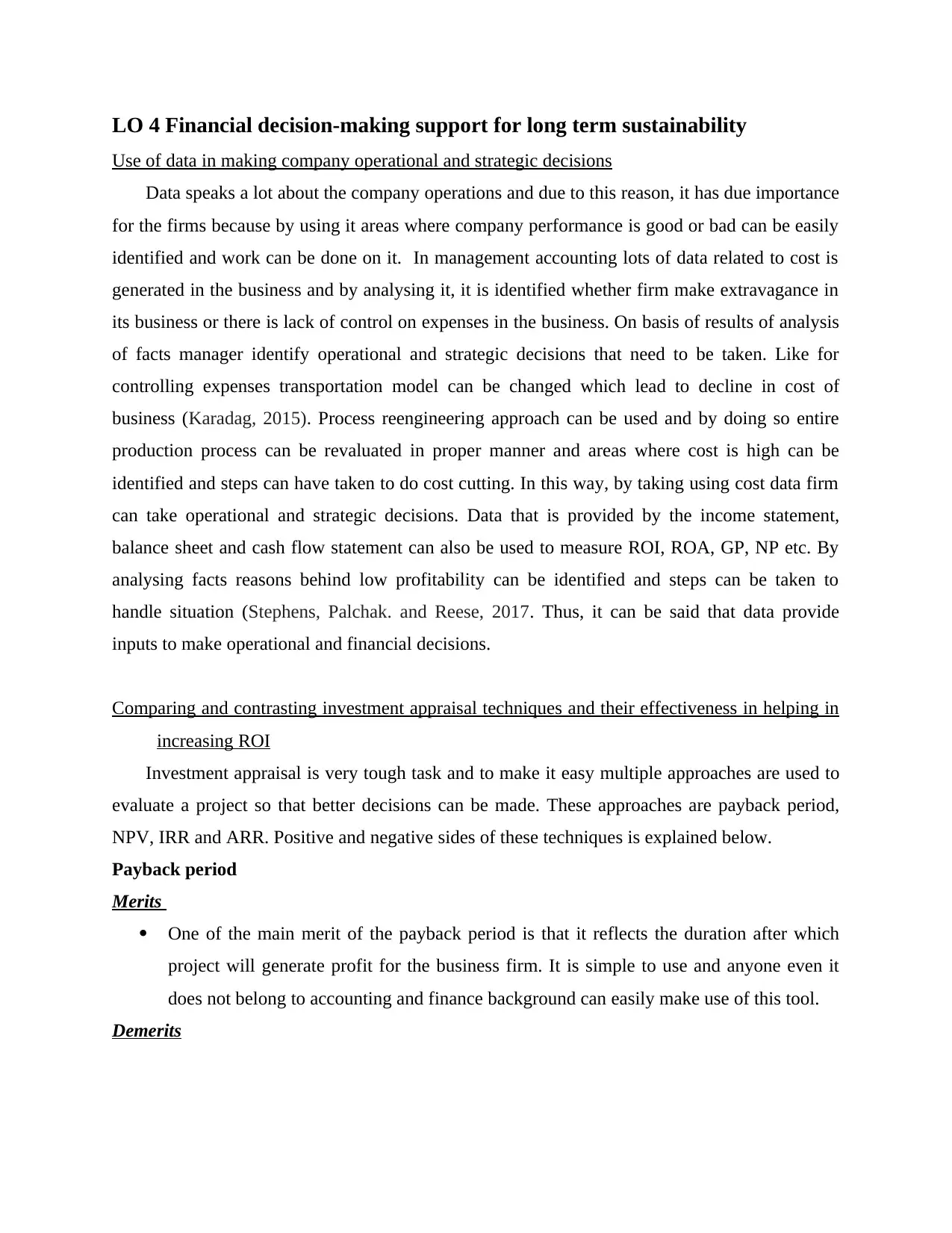
LO 4 Financial decision-making support for long term sustainability
Use of data in making company operational and strategic decisions
Data speaks a lot about the company operations and due to this reason, it has due importance
for the firms because by using it areas where company performance is good or bad can be easily
identified and work can be done on it. In management accounting lots of data related to cost is
generated in the business and by analysing it, it is identified whether firm make extravagance in
its business or there is lack of control on expenses in the business. On basis of results of analysis
of facts manager identify operational and strategic decisions that need to be taken. Like for
controlling expenses transportation model can be changed which lead to decline in cost of
business (Karadag, 2015). Process reengineering approach can be used and by doing so entire
production process can be revaluated in proper manner and areas where cost is high can be
identified and steps can have taken to do cost cutting. In this way, by taking using cost data firm
can take operational and strategic decisions. Data that is provided by the income statement,
balance sheet and cash flow statement can also be used to measure ROI, ROA, GP, NP etc. By
analysing facts reasons behind low profitability can be identified and steps can be taken to
handle situation (Stephens, Palchak. and Reese, 2017. Thus, it can be said that data provide
inputs to make operational and financial decisions.
Comparing and contrasting investment appraisal techniques and their effectiveness in helping in
increasing ROI
Investment appraisal is very tough task and to make it easy multiple approaches are used to
evaluate a project so that better decisions can be made. These approaches are payback period,
NPV, IRR and ARR. Positive and negative sides of these techniques is explained below.
Payback period
Merits
One of the main merit of the payback period is that it reflects the duration after which
project will generate profit for the business firm. It is simple to use and anyone even it
does not belong to accounting and finance background can easily make use of this tool.
Demerits
Use of data in making company operational and strategic decisions
Data speaks a lot about the company operations and due to this reason, it has due importance
for the firms because by using it areas where company performance is good or bad can be easily
identified and work can be done on it. In management accounting lots of data related to cost is
generated in the business and by analysing it, it is identified whether firm make extravagance in
its business or there is lack of control on expenses in the business. On basis of results of analysis
of facts manager identify operational and strategic decisions that need to be taken. Like for
controlling expenses transportation model can be changed which lead to decline in cost of
business (Karadag, 2015). Process reengineering approach can be used and by doing so entire
production process can be revaluated in proper manner and areas where cost is high can be
identified and steps can have taken to do cost cutting. In this way, by taking using cost data firm
can take operational and strategic decisions. Data that is provided by the income statement,
balance sheet and cash flow statement can also be used to measure ROI, ROA, GP, NP etc. By
analysing facts reasons behind low profitability can be identified and steps can be taken to
handle situation (Stephens, Palchak. and Reese, 2017. Thus, it can be said that data provide
inputs to make operational and financial decisions.
Comparing and contrasting investment appraisal techniques and their effectiveness in helping in
increasing ROI
Investment appraisal is very tough task and to make it easy multiple approaches are used to
evaluate a project so that better decisions can be made. These approaches are payback period,
NPV, IRR and ARR. Positive and negative sides of these techniques is explained below.
Payback period
Merits
One of the main merit of the payback period is that it reflects the duration after which
project will generate profit for the business firm. It is simple to use and anyone even it
does not belong to accounting and finance background can easily make use of this tool.
Demerits
Paraphrase This Document
Need a fresh take? Get an instant paraphrase of this document with our AI Paraphraser
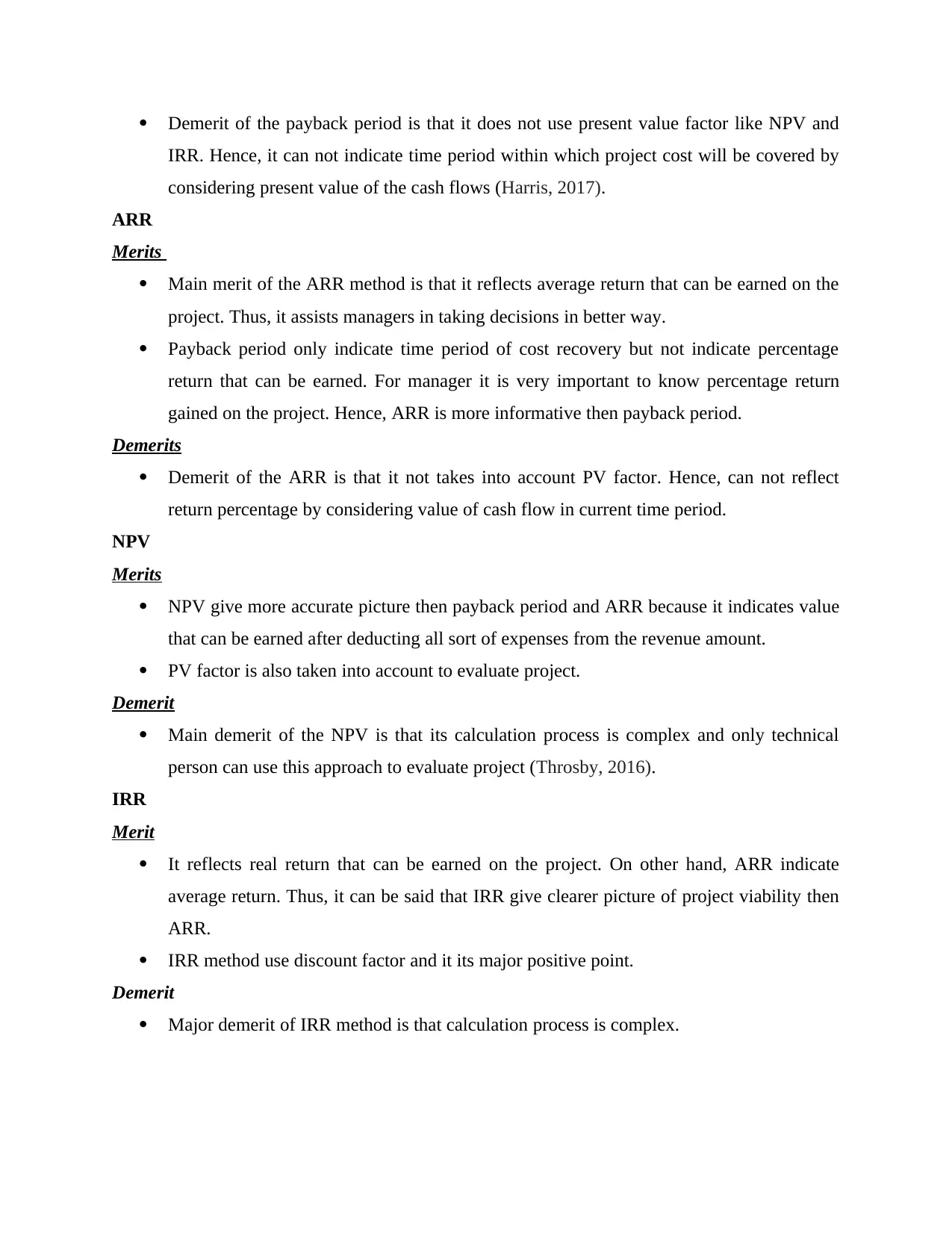
Demerit of the payback period is that it does not use present value factor like NPV and
IRR. Hence, it can not indicate time period within which project cost will be covered by
considering present value of the cash flows (Harris, 2017).
ARR
Merits
Main merit of the ARR method is that it reflects average return that can be earned on the
project. Thus, it assists managers in taking decisions in better way.
Payback period only indicate time period of cost recovery but not indicate percentage
return that can be earned. For manager it is very important to know percentage return
gained on the project. Hence, ARR is more informative then payback period.
Demerits
Demerit of the ARR is that it not takes into account PV factor. Hence, can not reflect
return percentage by considering value of cash flow in current time period.
NPV
Merits
NPV give more accurate picture then payback period and ARR because it indicates value
that can be earned after deducting all sort of expenses from the revenue amount.
PV factor is also taken into account to evaluate project.
Demerit
Main demerit of the NPV is that its calculation process is complex and only technical
person can use this approach to evaluate project (Throsby, 2016).
IRR
Merit
It reflects real return that can be earned on the project. On other hand, ARR indicate
average return. Thus, it can be said that IRR give clearer picture of project viability then
ARR.
IRR method use discount factor and it its major positive point.
Demerit
Major demerit of IRR method is that calculation process is complex.
IRR. Hence, it can not indicate time period within which project cost will be covered by
considering present value of the cash flows (Harris, 2017).
ARR
Merits
Main merit of the ARR method is that it reflects average return that can be earned on the
project. Thus, it assists managers in taking decisions in better way.
Payback period only indicate time period of cost recovery but not indicate percentage
return that can be earned. For manager it is very important to know percentage return
gained on the project. Hence, ARR is more informative then payback period.
Demerits
Demerit of the ARR is that it not takes into account PV factor. Hence, can not reflect
return percentage by considering value of cash flow in current time period.
NPV
Merits
NPV give more accurate picture then payback period and ARR because it indicates value
that can be earned after deducting all sort of expenses from the revenue amount.
PV factor is also taken into account to evaluate project.
Demerit
Main demerit of the NPV is that its calculation process is complex and only technical
person can use this approach to evaluate project (Throsby, 2016).
IRR
Merit
It reflects real return that can be earned on the project. On other hand, ARR indicate
average return. Thus, it can be said that IRR give clearer picture of project viability then
ARR.
IRR method use discount factor and it its major positive point.
Demerit
Major demerit of IRR method is that calculation process is complex.

Value of techniques in assisting firm to make financial decisions
Some of the techniques that assist firm in making financial decisions are given below. Income statement: It is the statement which reflect overall profitability of the business.
By evaluating income statement, one can easily find out expenses that are made on large
amount and heavily influence the profit of the firm to great extent. By working on such
kind of expenses profit in the business can be increased substantially. Thus, it can be said
that income statement provides an input to the managers for making financial decisions. Balance sheet: Balance sheet is also known as statement of financial position and it help
manager in evaluating firm performance in multiple ways (Hsu, 2016). By using ratio
analysis method in effective way company performance can be evaluate in the multiple
ways. Areas where performance is not good can be identified and steps can be taken
immediately to solve that problem. Thus, in this way balance sheet help firm in making
financial decisions. Cash flow statement: It is the statement which reflect cash flow from operating, investing
and financing activity. Sources and areas from where cash received and invested can be
identified through cash flows. By using this statement shift that is observed in the cash
flow in current year with previous one is identified and areas where less investment made
is identified. By picking relevant information and considering with other facts and figures
in better way business performance can be improved by taking appropriate financial
decision. Break even analysis: It is the technique which reflect minimum customers that must be
created in the business so that fixed and variable cost can be covered in the business (Li
and et.al., 2015). If firm is not able to create inevitable number of customers then it has to
cut its product and service cost so that target of customer creation can be reduced.
Financial decision making and long term sustainability
Barratt Developments plc
2018 2017
Liquidity ratio
Current assets 5726 5478
Some of the techniques that assist firm in making financial decisions are given below. Income statement: It is the statement which reflect overall profitability of the business.
By evaluating income statement, one can easily find out expenses that are made on large
amount and heavily influence the profit of the firm to great extent. By working on such
kind of expenses profit in the business can be increased substantially. Thus, it can be said
that income statement provides an input to the managers for making financial decisions. Balance sheet: Balance sheet is also known as statement of financial position and it help
manager in evaluating firm performance in multiple ways (Hsu, 2016). By using ratio
analysis method in effective way company performance can be evaluate in the multiple
ways. Areas where performance is not good can be identified and steps can be taken
immediately to solve that problem. Thus, in this way balance sheet help firm in making
financial decisions. Cash flow statement: It is the statement which reflect cash flow from operating, investing
and financing activity. Sources and areas from where cash received and invested can be
identified through cash flows. By using this statement shift that is observed in the cash
flow in current year with previous one is identified and areas where less investment made
is identified. By picking relevant information and considering with other facts and figures
in better way business performance can be improved by taking appropriate financial
decision. Break even analysis: It is the technique which reflect minimum customers that must be
created in the business so that fixed and variable cost can be covered in the business (Li
and et.al., 2015). If firm is not able to create inevitable number of customers then it has to
cut its product and service cost so that target of customer creation can be reduced.
Financial decision making and long term sustainability
Barratt Developments plc
2018 2017
Liquidity ratio
Current assets 5726 5478
⊘ This is a preview!⊘
Do you want full access?
Subscribe today to unlock all pages.

Trusted by 1+ million students worldwide
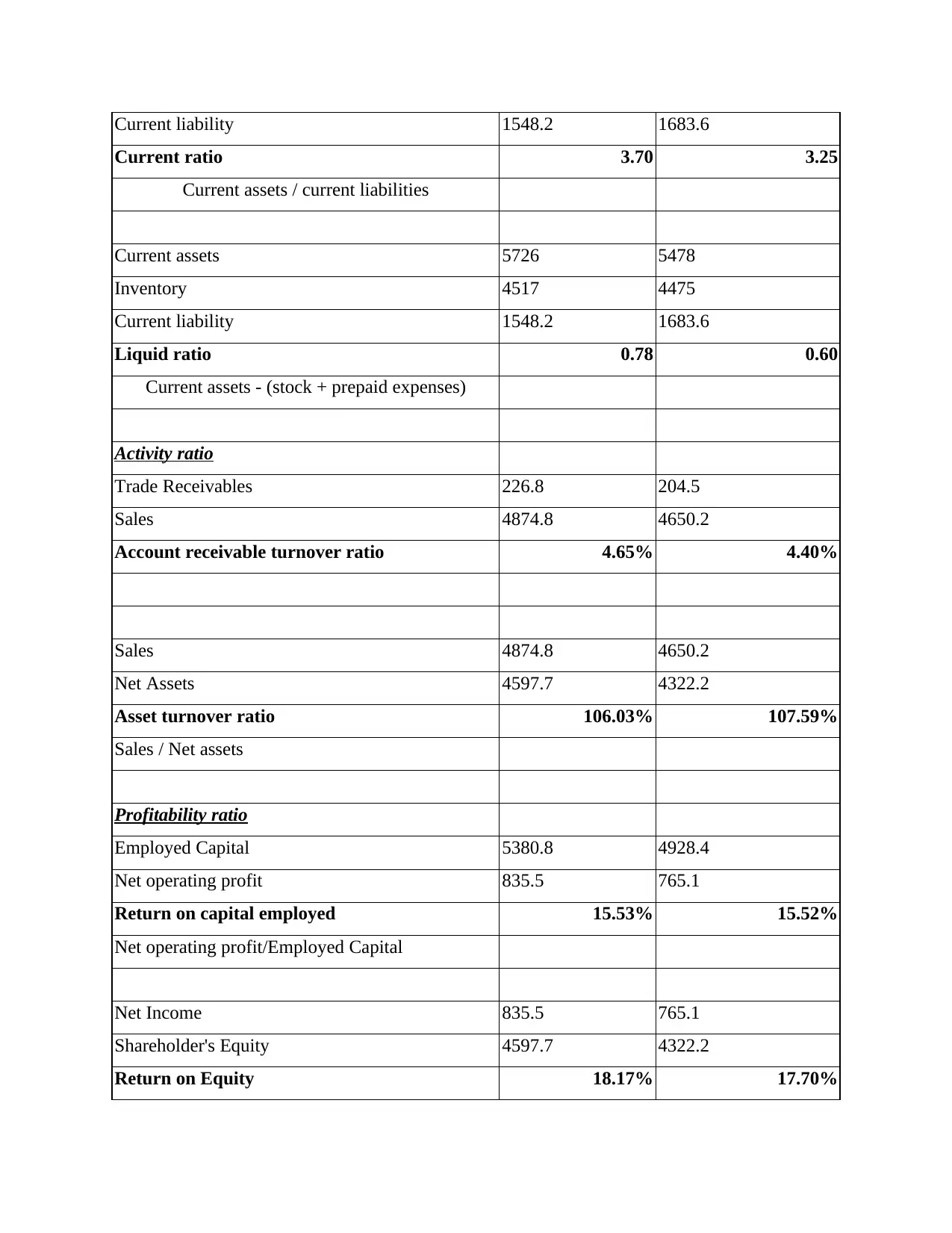
Current liability 1548.2 1683.6
Current ratio 3.70 3.25
Current assets / current liabilities
Current assets 5726 5478
Inventory 4517 4475
Current liability 1548.2 1683.6
Liquid ratio 0.78 0.60
Current assets - (stock + prepaid expenses)
Activity ratio
Trade Receivables 226.8 204.5
Sales 4874.8 4650.2
Account receivable turnover ratio 4.65% 4.40%
Sales 4874.8 4650.2
Net Assets 4597.7 4322.2
Asset turnover ratio 106.03% 107.59%
Sales / Net assets
Profitability ratio
Employed Capital 5380.8 4928.4
Net operating profit 835.5 765.1
Return on capital employed 15.53% 15.52%
Net operating profit/Employed Capital
Net Income 835.5 765.1
Shareholder's Equity 4597.7 4322.2
Return on Equity 18.17% 17.70%
Current ratio 3.70 3.25
Current assets / current liabilities
Current assets 5726 5478
Inventory 4517 4475
Current liability 1548.2 1683.6
Liquid ratio 0.78 0.60
Current assets - (stock + prepaid expenses)
Activity ratio
Trade Receivables 226.8 204.5
Sales 4874.8 4650.2
Account receivable turnover ratio 4.65% 4.40%
Sales 4874.8 4650.2
Net Assets 4597.7 4322.2
Asset turnover ratio 106.03% 107.59%
Sales / Net assets
Profitability ratio
Employed Capital 5380.8 4928.4
Net operating profit 835.5 765.1
Return on capital employed 15.53% 15.52%
Net operating profit/Employed Capital
Net Income 835.5 765.1
Shareholder's Equity 4597.7 4322.2
Return on Equity 18.17% 17.70%
Paraphrase This Document
Need a fresh take? Get an instant paraphrase of this document with our AI Paraphraser
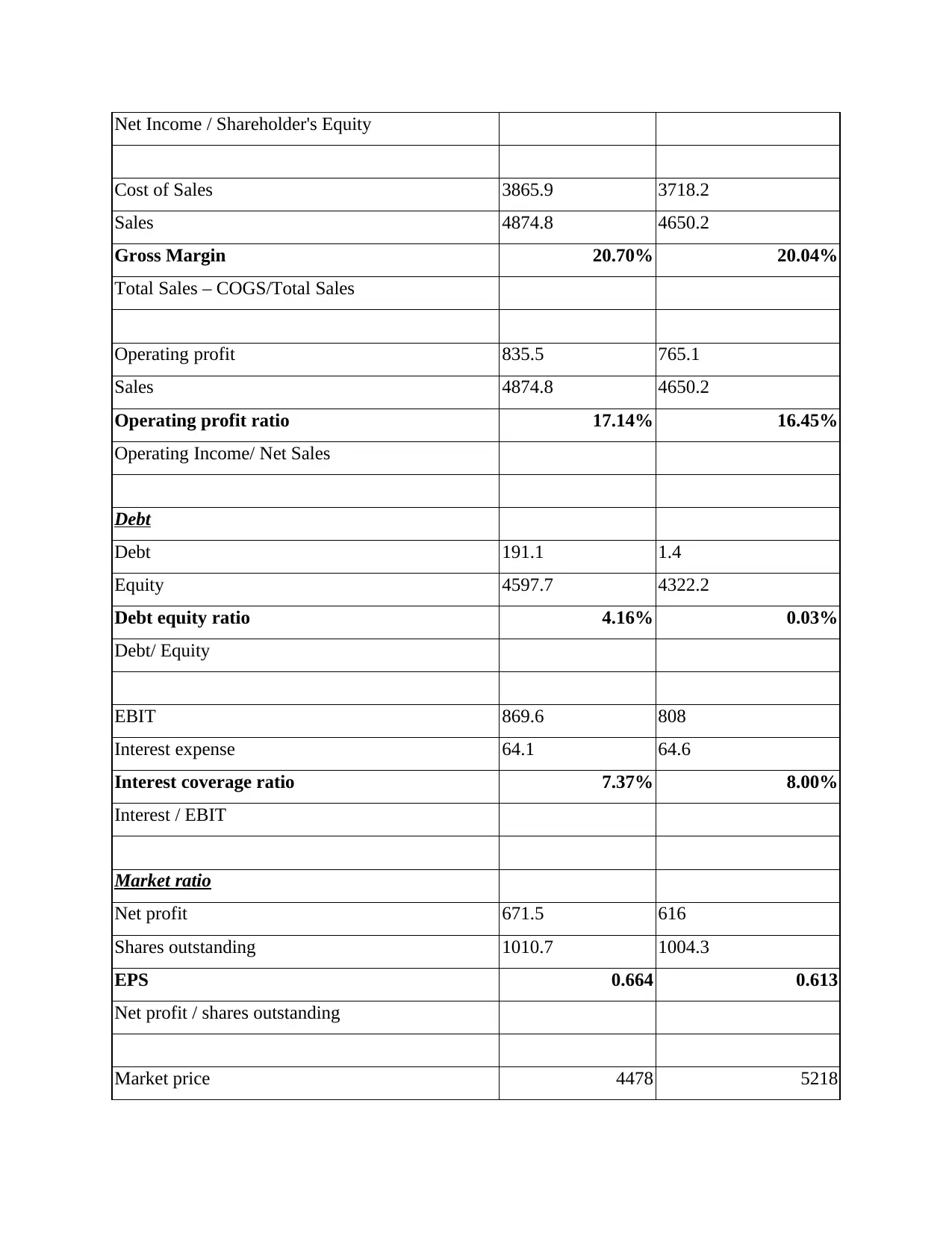
Net Income / Shareholder's Equity
Cost of Sales 3865.9 3718.2
Sales 4874.8 4650.2
Gross Margin 20.70% 20.04%
Total Sales – COGS/Total Sales
Operating profit 835.5 765.1
Sales 4874.8 4650.2
Operating profit ratio 17.14% 16.45%
Operating Income/ Net Sales
Debt
Debt 191.1 1.4
Equity 4597.7 4322.2
Debt equity ratio 4.16% 0.03%
Debt/ Equity
EBIT 869.6 808
Interest expense 64.1 64.6
Interest coverage ratio 7.37% 8.00%
Interest / EBIT
Market ratio
Net profit 671.5 616
Shares outstanding 1010.7 1004.3
EPS 0.664 0.613
Net profit / shares outstanding
Market price 4478 5218
Cost of Sales 3865.9 3718.2
Sales 4874.8 4650.2
Gross Margin 20.70% 20.04%
Total Sales – COGS/Total Sales
Operating profit 835.5 765.1
Sales 4874.8 4650.2
Operating profit ratio 17.14% 16.45%
Operating Income/ Net Sales
Debt
Debt 191.1 1.4
Equity 4597.7 4322.2
Debt equity ratio 4.16% 0.03%
Debt/ Equity
EBIT 869.6 808
Interest expense 64.1 64.6
Interest coverage ratio 7.37% 8.00%
Interest / EBIT
Market ratio
Net profit 671.5 616
Shares outstanding 1010.7 1004.3
EPS 0.664 0.613
Net profit / shares outstanding
Market price 4478 5218
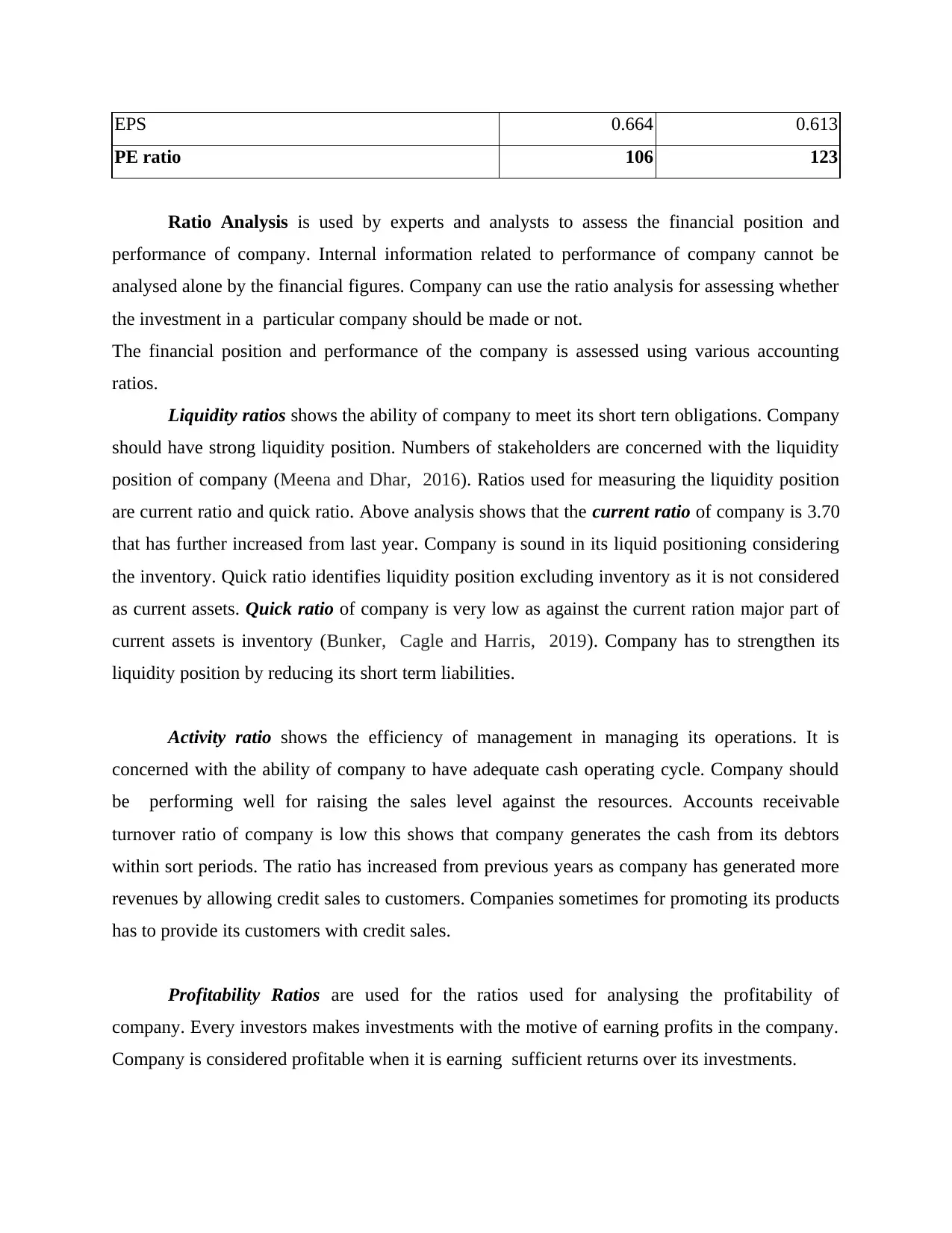
EPS 0.664 0.613
PE ratio 106 123
Ratio Analysis is used by experts and analysts to assess the financial position and
performance of company. Internal information related to performance of company cannot be
analysed alone by the financial figures. Company can use the ratio analysis for assessing whether
the investment in a particular company should be made or not.
The financial position and performance of the company is assessed using various accounting
ratios.
Liquidity ratios shows the ability of company to meet its short tern obligations. Company
should have strong liquidity position. Numbers of stakeholders are concerned with the liquidity
position of company (Meena and Dhar, 2016). Ratios used for measuring the liquidity position
are current ratio and quick ratio. Above analysis shows that the current ratio of company is 3.70
that has further increased from last year. Company is sound in its liquid positioning considering
the inventory. Quick ratio identifies liquidity position excluding inventory as it is not considered
as current assets. Quick ratio of company is very low as against the current ration major part of
current assets is inventory (Bunker, Cagle and Harris, 2019). Company has to strengthen its
liquidity position by reducing its short term liabilities.
Activity ratio shows the efficiency of management in managing its operations. It is
concerned with the ability of company to have adequate cash operating cycle. Company should
be performing well for raising the sales level against the resources. Accounts receivable
turnover ratio of company is low this shows that company generates the cash from its debtors
within sort periods. The ratio has increased from previous years as company has generated more
revenues by allowing credit sales to customers. Companies sometimes for promoting its products
has to provide its customers with credit sales.
Profitability Ratios are used for the ratios used for analysing the profitability of
company. Every investors makes investments with the motive of earning profits in the company.
Company is considered profitable when it is earning sufficient returns over its investments.
PE ratio 106 123
Ratio Analysis is used by experts and analysts to assess the financial position and
performance of company. Internal information related to performance of company cannot be
analysed alone by the financial figures. Company can use the ratio analysis for assessing whether
the investment in a particular company should be made or not.
The financial position and performance of the company is assessed using various accounting
ratios.
Liquidity ratios shows the ability of company to meet its short tern obligations. Company
should have strong liquidity position. Numbers of stakeholders are concerned with the liquidity
position of company (Meena and Dhar, 2016). Ratios used for measuring the liquidity position
are current ratio and quick ratio. Above analysis shows that the current ratio of company is 3.70
that has further increased from last year. Company is sound in its liquid positioning considering
the inventory. Quick ratio identifies liquidity position excluding inventory as it is not considered
as current assets. Quick ratio of company is very low as against the current ration major part of
current assets is inventory (Bunker, Cagle and Harris, 2019). Company has to strengthen its
liquidity position by reducing its short term liabilities.
Activity ratio shows the efficiency of management in managing its operations. It is
concerned with the ability of company to have adequate cash operating cycle. Company should
be performing well for raising the sales level against the resources. Accounts receivable
turnover ratio of company is low this shows that company generates the cash from its debtors
within sort periods. The ratio has increased from previous years as company has generated more
revenues by allowing credit sales to customers. Companies sometimes for promoting its products
has to provide its customers with credit sales.
Profitability Ratios are used for the ratios used for analysing the profitability of
company. Every investors makes investments with the motive of earning profits in the company.
Company is considered profitable when it is earning sufficient returns over its investments.
⊘ This is a preview!⊘
Do you want full access?
Subscribe today to unlock all pages.

Trusted by 1+ million students worldwide
1 out of 17
Related Documents
Your All-in-One AI-Powered Toolkit for Academic Success.
+13062052269
info@desklib.com
Available 24*7 on WhatsApp / Email
![[object Object]](/_next/static/media/star-bottom.7253800d.svg)
Unlock your academic potential
Copyright © 2020–2025 A2Z Services. All Rights Reserved. Developed and managed by ZUCOL.





